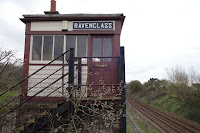locomotives and carriages as well as smaller artefacts and interactive displays.
Miniature locomotives
An old locomotive
Hello, I'm Katie!!
Interesting, isn't it?
Trunks used in the olden days when travelling
Me, VIP passenger!!
So many controls!!
My grandson found it especially interesting!
Thin Controller!! Not the Fat Controller of Thomas the Tank Engine!!
After spending sometime in the museum, it was time to make our way back to catch
the steam engine that would take our train back to Dale for Boot. It was really
a lovely day.
Profusion of daffodils along the rail track
The train journey took us back through the same scenarios which we passed earlier
in the morning.
Pretty countryside
A bridge to go under
On arrival at Dalegarth for Boot, we didn’t return via the hills. We were smarter
and took the motorway back to Windermere. Besides, it was getting dark and the
motorway was a safer bet to get back faster.



















































